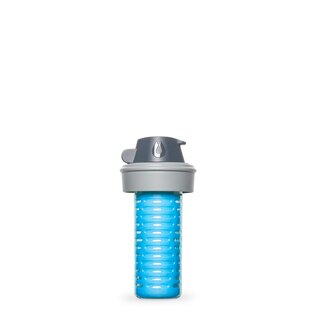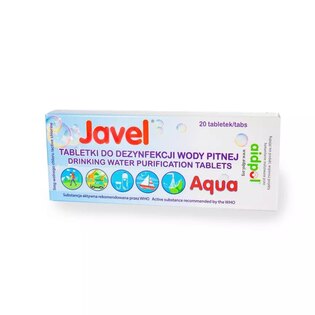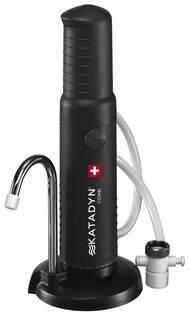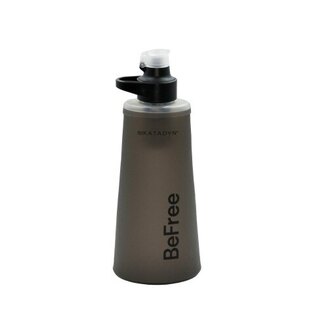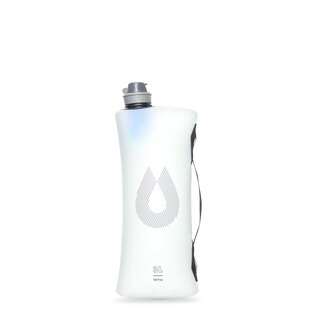How to Choose a Water Filter for Outdoor Adventures, Travel, or High-Risk Areas: A Practical Guide
Today, a water filter is no longer just a luxury piece of gear. In many cases, it’s essential for staying hydrated safely—whether you’re in the wild, traveling abroad, or facing an emergency. This guide walks you through four key steps to help you pick the right filter for your trip style, the environment you'll be in, and the level of protection you need.
Clean drinking water is never guaranteed—especially in nature or abroad. Even sources that look pristine can harbor bacteria, parasites, or chemical contaminants. A reliable filter significantly reduces health risks, saves you the weight and space of carrying large water reserves, and, if chosen well, can handle tough conditions. But to get the right one, you need to know what to expect—and how to match it to your needs.
Imagine standing by a river deep in the Romanian mountains. The sun is beating down, your pack feels heavier by the minute, and your hydration bladder is bone dry. The river’s right there—but you have no idea what lies upstream. A pasture? A village? A sewage outlet? The choice you make in that moment could mean the difference between a safe drink and days of stomach trouble.
To avoid such setbacks, it’s worth investing a bit of time in selecting the right filter. It’s not about brand popularity—it’s about performance, efficiency, and how well the filter fits your environment and travel style. In the next four steps, we’ll break down everything you need to know.
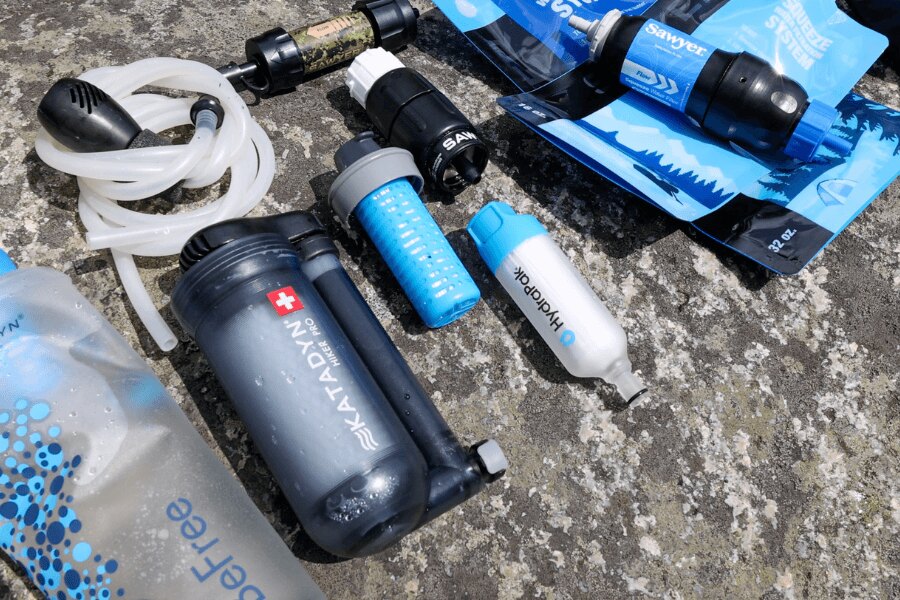
Various types of portable water filters – a comparison of products for different outdoor scenarios.
What to Clarify Before Choosing a Water Filter
Before you start making a specific choice, it's worth answering a few basic questions. This will clarify your priorities and narrow down the selection to technologies and solutions that make the most sense in the given situation:
- How much water do I need each day?
A solo hiker on a weekend trek will need a different filter than a group camping for several days or an expedition team.
- Where will I use the filter most often?
Your needs will vary depending on whether you travel light, hike in the mountains, explore humid tropical regions, or stay in established campsites.
- What types of water sources will I use?
Springs, creeks, rivers, municipal water, tap water, or unknown sources? The quality and origin of your water are key factors.
- How much time and space can I dedicate to maintenance?
Some filters require regular backflushing or cleaning. Others are maintenance-free but may operate more slowly or rely on chemicals.
- Do I need a long-term solution or just a backup?
Consider the filter’s lifespan, replaceability, durability, and comfort of use. In some cases, combining two filter types can be the most practical approach.
🟦 Step 1: Key Criteria for Choosing a Water Filter
You don’t choose a water filter based on color, brand, or price—but on what it can do and in which conditions it performs best. To be effective in the field, it should suit not only the environment you’ll be in but also your travel style, comfort expectations, and the number of people it needs to serve.
Here are the key criteria you'll encounter when selecting a water filter:
🟠 Filtration Effectiveness
The key question: What do you need the filter to protect you from?
Basic mechanical filters reliably remove most bacteria and parasites (such as Giardia or E. coli), but they don’t always eliminate viruses or chemical contaminants. Viruses are smaller than 0.1 microns—so a standard 0.2 µm filter won’t catch them. To neutralize viruses, you’ll need either a chemical purifier or a UV treatment device.
👉 TIP: If you're traveling to areas with a high risk of viral contamination (e.g. urban water in tropical regions or rivers in developing countries), look for solutions that combine multiple technologies.
🟠 Ease of Use & Physical Effort
Filters can be pumped, squeezed, hung from a tree, or used like a straw. Some work passively (gravity filters), while others require manual input (pump filters). What matters is how much time and effort you’re willing to put in for each liter of water.
👉 Example: A gravity filter is ideal for setting up camp with a group. For a solo day hike where you want to hydrate quickly and move on, a squeeze or bottle filter is more practical.
🟠 Filtration Speed
Each filter comes with an approximate flow rate—usually between 0.5 and 3 liters per minute.
UV purifiers can treat one liter in 90 seconds—but only with clear water. Chemical tablets typically take 30 minutes or more. If you need to filter large volumes or are short on time, flow rate becomes more important than you might think.
🟠 Capacity & Group Suitability
A filter that works great for one person might not be efficient for a group. What matters is not just the speed, but also how much water it can process before needing maintenance or cartridge replacement. Some models handle over a liter per minute; others only a few hundred milliliters.
🟠 Maintenance & Reliability
In the field, you need a filter you can depend on. Some require only a rinse with clean water, while others need membrane cleaning or partial disassembly. It’s also crucial to consider whether the filter works without spare parts—and whether those parts are even available if needed.
🟠 Lifespan & Replaceable Components
Filters vary widely in lifespan—from a few hundred liters to tens of thousands. Check whether the cartridge is replaceable and what happens when the filter reaches the end of its life. For some models, capacity alone determines lifespan; for others, factors like sediment load or freezing conditions also matter.
🟠 Weight, Size & Packability
If you’re planning a long-distance hike or flying with limited luggage, every gram and every centimeter count. In contrast, for car camping or basecamp use, bulk and weight are much less of a concern.
🟠 Compatibility & Setup Options
Some filters connect directly to PET bottles; others are designed to work with water bladders or come with their own reservoirs. Make sure you understand what gear you’ll carry—and what you’ll actually use in the field.
| Parameter | What It Means | Which Filter Types Score Here | Key Advantage |
|---|---|---|---|
| Filtration Effectiveness | What the filter protects against – bacteria, parasites, viruses, chemicals | UV purifiers, activated carbon filters, combinations | Broad-spectrum protection, including viruses and chemicals |
| Ease of Use | How the filter is operated, and how much time/effort it takes | Gravity, bottle filters | No pumping required, quick deployment |
| Filtration Speed | How much water it can clean per minute or cycle | UV purifiers, pump filters | Fast processing – ideal when time is limited |
| Capacity | How much water the filter can handle at once or per day | Gravity (groups), bottle/squeeze (individuals) | Adaptable to group size and situation |
| Maintenance & Servicing | Cleaning frequency and replaceability | Squeeze filters, UV purifiers | Easy maintenance or maintenance-free use |
| Lifespan | How much water it can filter before replacement is needed | Squeeze filters (e.g. Sawyer Mini, Micro) | Long durability, replacement needed only if damaged |
| Weight & Size | How much the filter adds to your pack load | Straw, squeeze, bottle filters | Lightweight and compact with no extra containers needed |
| Compatibility | Can it connect to PET bottles, bladders, hydration systems, etc.? | Squeeze filters, some pump/gravity systems | Flexible use with standard bottles, bladders, or tubing |
🟦 Step 2: Selection of a water filter according to the expedition style
Different types of expeditions place different demands on a filter. What works for a solo mountain crossing might be unnecessarily slow or impractical at a group camp. And what works on a Czech trail might not be sufficient abroad. Before you start comparing specific types, it is good to clarify how and where you plan to use the filter.
| Expedition Style | What the Filter Needs to Handle | Suitable Filter Types |
|---|---|---|
| 🥾 Solo Trek / Ultralight | Low weight, simple operation, minimal accessories | Squeeze, bottle, straw filters |
| 🏕️ Group Camping | High water volume, easy to use, shareable among people | Gravity filters, large pump systems |
| 🎒 Fully Loaded Trek / Extended Trips | Long lifespan, serviceable design, durable build | Pump filters, backflushable squeeze filters |
| 🚴♂️ Running, Day Hikes, Bikepacking | Quick access to water, easy to carry on the move | Bottle filters, mini squeeze |
| 🆘 Emergency / Backup Use | Lightweight, compact, long shelf life | Chemical purifiers, straw filters, tablets |
| 🌍 Travel to High-Risk Regions | Protection against viruses and chemicals, ability to combine filtration and purification | UV purifiers + mechanical filters, or integrated systems |
The type of trip you’re planning often determines the trade-offs you'll need to make—between weight, flow rate, convenience, and reliability. If you're carrying everything on your back, your choices will be very different from someone traveling in a camper van or backpacking through Asia. This initial categorization helps narrow down your options and sets the stage for the next step: assessing the environment where you'll actually be filtering water.
👉 Remember: No filter does everything perfectly. In many cases, the most effective approach is to combine multiple types—such as a mechanical filter for bacteria plus chemical drops for viruses, or a squeeze filter for the trail paired with a UV purifier for evening use at camp.
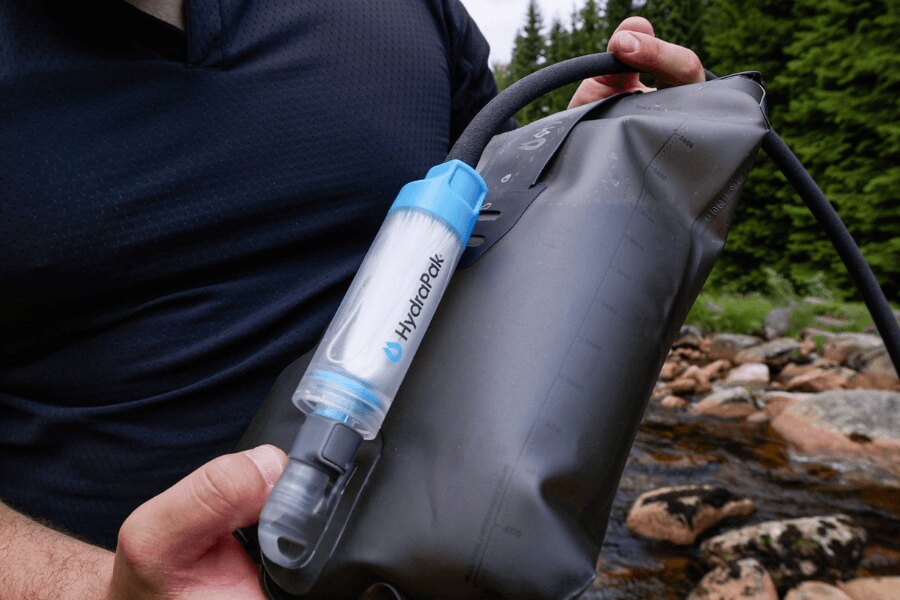
Close-up of the HydraPak® filter attached to a reservoir system using a Plug-N-Play adapter.
🟦 Step 3: Choosing a Filter Based on Environment and Water Quality
The environment plays a critical role in determining which type of filter will perform reliably—and which one may fall short. Filtering a clear alpine stream high in the mountains is very different from dealing with a murky lagoon on the edge of a tropical village. And even crystal-clear water can hide risks—a pasture or a dead animal upstream can contaminate what looks perfectly safe.
Consider the following breakdown as a general guide. It will help you narrow your selection based on expected water quality and adapt your gear to the common risks in the region you plan to visit.
| Environment | Source Characteristics | Recommended Solution |
|---|---|---|
| 🇨🇿 Czech Republic & Central Europe | Rivers, streams, and springs with low viral risk. Potential contamination from agriculture or livestock. | Mechanical filters (squeeze, pump, gravity); chemical drops as a backup |
| 🏔 Mountains & Wilderness in Europe | Clean snowmelt or alpine streams. Localized contamination risk from animals or grazing. | Squeeze or gravity filter, lightweight setup, UV purifier as a supplement |
| 🌴 Exotic Countries & Tropical Regions | Elevated risk of viruses, parasites, and chemical contamination—even in tap water | Combination of mechanical filter + chemical disinfectant or UV purifier |
| 🏙 Cities with Unclear Infrastructure | Potential presence of chlorine, heavy metals, organic pollutants, or viruses in tap water | Activated carbon filter + UV or chemical treatment (for clear water) |
| ⚠️ Developing Countries or Crisis Zones | Heavily contaminated or turbid sources, risk of viruses, chemicals, and heavy metals | High-performance filters (e.g. Sawyer S3, MSR Guardian) + chemical or UV purification |
👉 Field Tip: In some parts of the world—such as Southeast Asia, Africa, or South America—contamination is so widespread that even tap water should not be consumed without treatment. In these situations, always use a combination of a filter and a purifier—mechanical filtration alone may not be sufficient.
🟦 Step 4: Types of Water Filters and How They Compare
There are several types of water filters on the market—each differing not only in technology, but also in how they’re used, their flow rate, weight, and what contaminants they can remove. In this section, we’ll give you a clear overview of each type, including:
- How it works
- Who it’s suitable for
- Benefits and limitations
- Specific recommendations from the Rigad product range
💧 Gravity Filters
How they work:
A hanging reservoir filled with dirty water uses gravity to draw water through the filter into a clean container.
Best for:
Campsites, groups, families
✅ Advantages:
- No effort required during filtration
- Suitable for filtering large volumes of water
- Can serve as a basecamp water system
❌ Disadvantages:
- Slower than pump filters
- Requires a suitable place to hang the reservoir
- Not ideal for collecting water from shallow sources
💧 HydraPak® 28 mm Water Filter
A lightweight and compact mechanical filter with hollow fiber membrane technology, suitable for both squeeze and gravity use.
Compatible with all bottles and containers with a 28 mm neck – including:
- Seeker™ Collapsible Water Container by HydraPak® (various sizes)
- Flux™ Collapsible Bottle by HydraPak® – 1.5 L
- Flux™ Collapsible Bottle by HydraPak® – 1 L
- Flux™ Collapsible Bottle by HydraPak® – 750 ml
Filters out:
- ✅ Bacteria (e.g. E. coli)
- ✅ Parasites and cysts (e.g. Giardia lamblia)
- ✅ Microplastics and solid particles
Does not remove:
- ❌ Viruses (combine with chemical treatment or boiling if needed)
- ❌ Chemical contaminants (e.g. heavy metals, pesticides)
Additional specifications:
- Weight: approx. 40 g
- Flow rate: 1 L/min
- Filter life: up to 1000 liters (depending on water quality)
- Maintenance: backflushing with clean water

Gravity filtration in action – a suspended HydraPak® reservoir with a filter, allowing water to flow freely without pumping.
💧 Pump Filters
How they work:
Water is manually pumped through a membrane—works even with shallow or hard-to-reach sources.
Best for:
Long-distance treks, pairs, expeditions needing fast access to water
✅ Advantages:
- Fast, on-demand filtration
- Works well with shallow or tricky water sources
- Easy to monitor water flow
❌ Disadvantages:
- Requires regular maintenance and backflushing
- Heavier and more complex than other options
💧 Hiker Pro Portable Water Filter by KATADYN®
A reliable pump-action filter ideal for long treks and multi-day expeditions where quick access to large amounts of water is essential. Combines mechanical microfiltration with activated carbon for improved taste and odor removal.
- 💪 Pump mechanism – easy to use even with shallow sources
- 🔬 Filtration media: 0.2 µm hollow fibers + activated carbon
- 💧 Flow rate: approx. 1 liter per minute
- 🎒 Weight: 310 g
- 🔄 Filter life: approx. 750–1150 liters (depending on water quality)
- 🧩 Compatibility: connects to hydration bladders and PET bottles (Quick-Connect system)
- 🌍 Filters: bacteria, protozoa (Giardia, Cryptosporidium), microplastics, partially chemicals and odors
- ⚠️ Does not filter: viruses – for high-risk regions, we recommend combining with a UV or chemical purifier
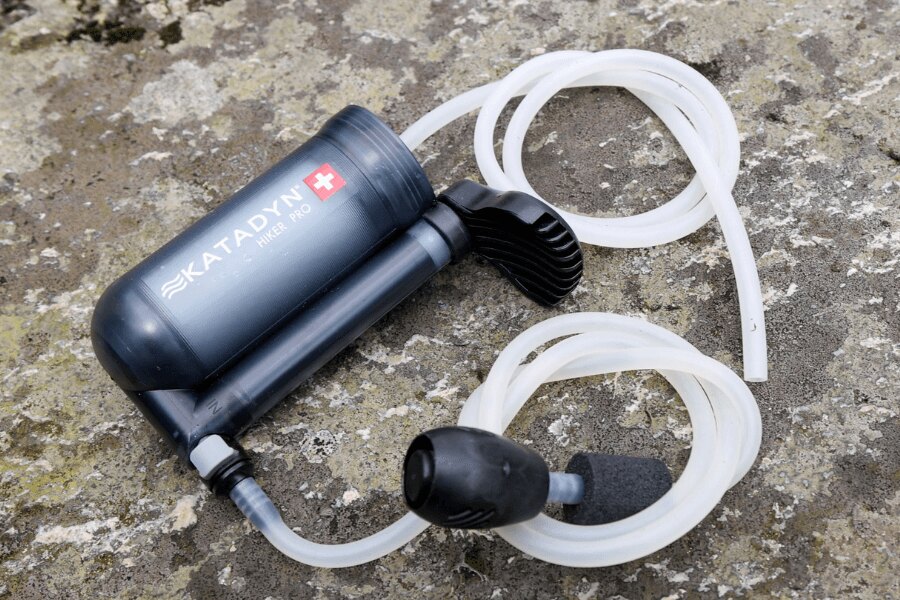
Katadyn Hiker Pro pump filter – ideal for fast water filtration, even from shallow sources.
💧 UV water cleaners
How they work:
Use ultraviolet light to deactivate viruses, bacteria, and parasites in clear water.
Best for:
Travelers in urban areas or exotic destinations
✅ Advantages:
- Fast purification (up to 1 liter in 90 seconds)
- No taste or odor added
- No need for replacement filters
❌ Disadvantages:
- Does not purify cloudy or murky water
- Requires batteries or charging
- Best used as a supplementary method
⚠️ Note: UV purifiers are not currently included in the Rigad product range. If viral protection is a priority, you can substitute with chemical disinfection or boil the water after mechanical filtration.
💧 Bottle Filters
How they work:
Water is filtered as you drink directly from the bottle—an internal filter removes contaminants.
Best for:
Runners, bikepackers, day hikers
✅ Advantages:
- Maximum simplicity
- Lightweight design
- Instant access to clean drinking water
❌ Disadvantages:
- Small water capacity
- Not suitable as a source for cooking or group use
💧 S1 Foam Filter Bottle by SAWYER®
An advanced bottle-style filter with a replaceable foam insert that combines mechanical and chemical filtration. Designed for direct drinking from the bottle – ideal for travel, sports, and emergency situations.
Filters and reduces:
- ✅ Bacteria (e.g. E. coli)
- ✅ Parasites (e.g. Giardia, Cryptosporidium)
- ✅ Microplastics and particulate matter
- ✅ Chemicals (e.g. pesticides, herbicides)
- ✅ Heavy metals (e.g. lead)
- ✅ Unpleasant odors and tastes
Does not remove:
- ❌ Viruses (recommended to combine with chemical treatment in high-risk areas)
Additional specifications:
- Bottle capacity: approx. 0.6 L
- Replaceable foam cartridge (S1, S2, S3 – different filtration levels)
- Can be used as a standalone solution or as a supplement to mechanical filters
💧 Squeeze Filters
How they work:
Fill a soft container with water, then squeeze it to push water through the filter.
Best for:
Ultralight adventures, solo travelers
✅ Advantages:
- Lightweight, compact, and simple to use
- Can double as a straw, connect directly to a stove, or integrate with a hydration bladder
- Long lifespan (up to 100,000 liters for Sawyer models)
❌ Disadvantages:
- Slower when filtering larger volumes
- Requires a soft bottle or squeeze pouch
💧 Cap Water Filter by HydraPak®, 42 mm
An ultralight and compact cap-style filter designed for squeeze or gravity use. Perfect for adventures where every gram counts – it weighs just 42 grams.
Compatible with:
Filters out:
- ✅ Bacteria (e.g. E. coli)
- ✅ Parasites and cysts (e.g. Giardia, Cryptosporidium)
- ✅ Microplastics and suspended solids
Does not remove:
- ❌ Viruses (recommended to combine with chemical treatment or boiling)
- ❌ Chemical contaminants (e.g. heavy metals, pesticides)
Additional specifications:
- Weight: approx. 42 g
- Flow rate: up to 1 L/min
- Filter life: up to 1500 liters (depending on water quality)
- Filtration technology: hollow fiber membrane (0.2 µm)
- Easy to use – no pumping required
🟡 Alternative: Tactical BeFree KATADYN® – a hybrid filter that combines the benefits of a squeeze system and a bottle-style design. The filter is built directly into a soft bottle, allowing you to either drink straight from it or squeeze water into another container.
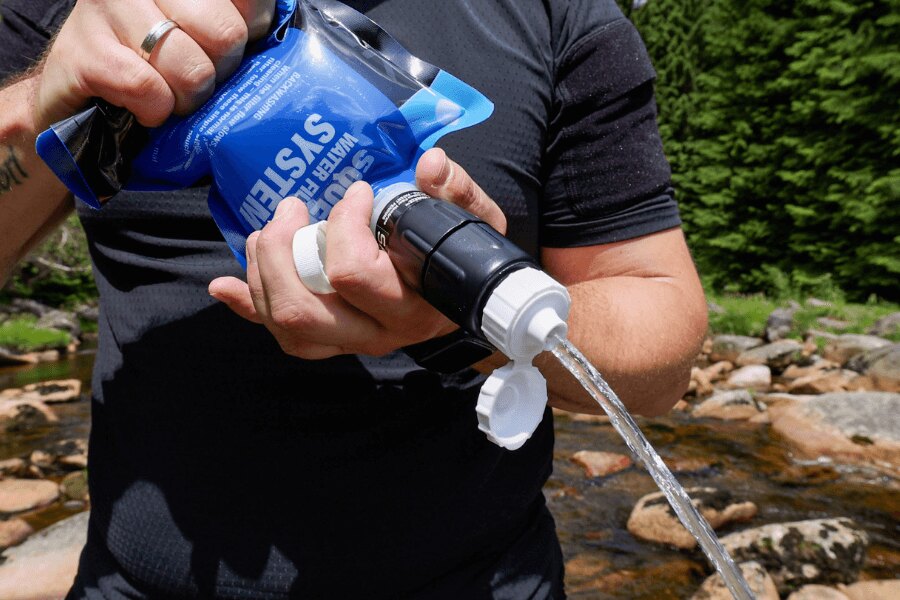
Sawyer squeeze system – water is filtered by pressing the reservoir, ideal for solo adventures.
💧 Chemical Purifiers (Tablets, Drops)
How they work:
After adding the disinfectant to the water, you let it sit for a specified period—this process kills microorganisms.
Best for:
Backup solutions or in combination with mechanical filtration
✅ Advantages:
- Extremely lightweight and compact
- Maintenance-free, no power or mechanical parts required
- Long shelf life and high number of doses per package
- Some variants (e.g. silver-based) can keep water stable for up to 6 months
❌ Disadvantages:
- Longer treatment time: typically 30–120 minutes
- May leave an unpleasant taste (especially iodine- or chlorine-based products)
- Do not remove turbidity or physical contaminants
- Not suitable for long-term use (e.g. iodine is not recommended for pregnant individuals or people with thyroid issues)
💧 KATADYN® Chemical Water Purifiers
A reliable solution for water disinfection using proven active ingredients. Ideal as a backup system, a supplement to filters, or for travel in high-risk areas.
✅ Micropur Forte MF 1T (tablets)
- 💊 50 tablets – 1 tablet treats 1 liter of water
- 🦠 Kills bacteria, viruses, and protozoa (chlorine + silver)
- 🕒 Contact time: 30 minutes (clear water), up to 2 hours (cold or turbid water)
- 🛡️ Preserves water for up to 6 months
💧 Straw Filters
How they work:
You drink directly from a natural water source through a compact straw-style filter.
Best for:
Emergency backup use
✅ Advantages:
- Extremely lightweight and compact
- Quick and simple way to drink from unfamiliar sources
❌ Disadvantages:
- Not suitable for collecting or storing water
- Not a practical solution for regular or long-term use
⚠️ Note: Straw filters are not currently available in the Rigad product range. As a more versatile alternative, we recommend the HydraPak® 28 mm filter—it can be used like a straw (for direct drinking), and also works with squeeze and gravity filtration setups.
💧 Tap Filters
How they work:
Tap filters connect directly to a faucet or outdoor spigot (typically using an adapter). When the tap is opened, water flows through the filter by gravity or water pressure—no pump or water bags required. They operate purely on mechanical filtration using existing water pressure.
Best for:
Perfect for campsites, cabins, RV travel, or as part of an emergency preparedness kit for the home. Ideal wherever there's a questionable tap water supply (e.g. during outages, floods, or plumbing failures).
✅ Advantages:
- Immediate filtration of large volumes (up to 1,900 liters per day)
- Very easy to use—no pumping or accessories needed
- Long-lasting and low-maintenance
- Suitable for households or larger groups
❌ Disadvantages:
- Requires direct connection to a tap—not usable in outdoor terrain
- Doesn’t function without water pressure—not compatible with bottles or natural sources
- Does not remove viruses or chemical contaminants
💧 SP134 TAP SAWYER® Travel Water Filter
A highly effective mechanical tap water filter, designed for easy connection to most indoor and outdoor faucets and spigots. It uses hollow fiber membrane technology with a pore size of 0.1 micron and requires no batteries, chemicals, or pressure system.
Filters:
- ✅ Bacteria (e.g. E. coli, Salmonella)
- ✅ Parasites and cysts (e.g. Giardia, Cryptosporidium)
- ✅ Microplastics and suspended solids
Does not remove:
- ❌ Viruses
- ❌ Chemical contaminants (e.g. pesticides, heavy metals)
Additional specifications:
- Flow rate: up to 1,900 liters/day (depending on water pressure)
- Lifespan: up to 375,000 liters with proper maintenance
- Compatibility: 17–20 mm faucets (fits most garden hoses and RV valves)
- Weight: approx. 141 g
- Maintenance: easy backflushing with included syringe
💧 Water Filtration for Groups and Expedition Basecamps
Challenging multi-day expeditions call for more than just a pocket-sized filter for individual use. Whether you're traveling as a group, embarking on an expedition, or setting up a basecamp without access to clean water, you’ll need a reliable, high-capacity system with long-term durability and strong flow performance.
Here is a proven solution from the Rigad range that meets those demanding requirements:
💧 Filters for Groups and Expedition Bases
✅ Combi Plus KATADYN® Portable Filter
- Durable ceramic and activated carbon filter with an option to connect to a tap
- Ideal for expeditions, basecamps, and long-term use
- Filtration capacity: up to 50,000 liters
- Also reduces chemical contaminants (taste and odor)
Summary: How to Choose the Right Water Filter
Choosing the right water filter depends on the environment you’ll be in, the types of water sources available, and how many people you need to provide water for. In this guide, we’ve broken the selection process down into four key steps:
1. Define your requirements:
How often and where will you use the filter? How much water do you need to process, and for how many people?
2. Consider your travel style:
A solo trek, family camping trip, or full expedition—each scenario has different demands in terms of weight, speed, and convenience.
3. Assess the environment:
A clean mountain spring requires a different approach than a tropical stream or heavily polluted river.
4. Choose the right filter type:
Pump, squeeze, gravity, UV, chemical, bottle, or straw—each has its strengths, limitations, and ideal use cases.
Readers are further interested







































































































































